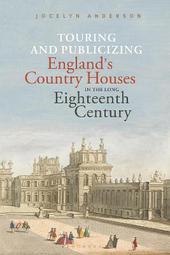
|
Touring and Publicizing England's Country Houses in the Long Eighteenth Century
Hardback
Main Details
| Title |
Touring and Publicizing England's Country Houses in the Long Eighteenth Century
|
| Authors and Contributors |
By (author) Dr. Jocelyn Anderson
|
| Physical Properties |
| Format:Hardback | | Pages:256 | | Dimensions(mm): Height 229,Width 152 |
|
| Category/Genre | Art and design styles - c 1600 to c 1800
History of architecture |
|---|
| ISBN/Barcode |
9781501334979
|
| Classifications | Dewey:728.80942 |
|---|
| Audience | | General | | Tertiary Education (US: College) | |
|---|
| Illustrations |
8 colour and 40 bw illus
|
|
Publishing Details |
| Publisher |
Bloomsbury Publishing Plc
|
| Imprint |
Bloomsbury Academic USA
|
| Publication Date |
22 February 2018 |
| Publication Country |
United States
|
Description
Over the course of the long 18th century, many of England's grandest country houses became known for displaying noteworthy architecture and design, large collections of sculptures and paintings, and expansive landscape gardens and parks. Although these houses continued to function as residences and spaces of elite retreat, they had powerful public identities: increasingly accessible to tourists and extensively described by travel writers, they began to be celebrated as sites of great importance to national culture. This book examines how these identities emerged, repositioning the importance of country houses in 18th-century Britain and exploring what it took to turn them into tourist attractions. Drawing on travel books, guidebooks, and dozens of tourists' diaries and letters, it explores what it meant to tour country houses such as Blenheim Palace, Chatsworth, Wilton, Kedleston and Burghley in the tumultuous 1700s. It also questions the legacies of these early tourists: both as a critical cultural practice in the 18th century and an extraordinary and controversial influence in British culture today, country-house tourism is a phenomenon that demands investigation.
Author Biography
Jocelyn Anderson is a Toronto-based art historian specializing in 18th-century British art and architecture.
ReviewsFor anyone who has ever wondered how Chatsworth, Pemberley, or Downton Abbey could belong so emphatically to the public-how English country houses (both real and imagined) have, as cultural treasures, come to be possessed by the nation-this book is essential reading. With an extraordinary range of primary sources, Anderson engagingly demonstrates the importance of English country houses as crucial tourist destinations in the 18th century, underscoring the importance of these houses for all sorts of things: not only the history of country house architecture, but also 'heritage' more broadly, collections generally, art collections in particular, and-perhaps most importantly-British conceptions of elite property as extending into the public realm of ownership. It is an immensely satisfying account of a fascinating story. * Craig Ashley Hanson, Associate Professor of Art History, Calvin College, USA, and author of The English Virtuoso: Art, Medicine, and Antiquarianism in the Age of Empiricism (2009) * Drawing on extensive primary research, Jocelyn Anderson explores the culture around country house visiting as it developed over the course of the eighteenth century. Bringing a broad range of literary and visual material together, her study examines how guidebooks, travel accounts, pictures, and plans, not only helped promote the growth of domestic tourism to such sites, but also served to condition a visitor's experience of a house and grounds. With the massive road-building campaigns of the mid-eighteenth century, and the development of an associated infrastructure of coach inns and taverns, opening up the country and easing travel, there was a ready commercial market among the polite classes eager to explore the nation's architectural landmarks and heritage in person and on paper. By highlighting these concerted efforts to encourage, stage and shape the phenomenon, Anderson's account effectively calls into question a number of scholarly assumptions about the origins of the public consumption of private property; not least as such often shrewd and sophisticated attempts to market and package the country house and its landscape to the tourist have been conventionally dated a good deal later. But it is a survey that prompts the reconsideration of wider concerns too, especially regarding a tendency to treat the cultural history of urban and rural areas discretely. Yet, while Anderson provides a valuable overview and astute interrogation of such issues, they never overwhelm the text. Well-informed and learned as it is, the book is accessible, deftly assembled, and eminently readable. It is an impressive piece of scholarship that makes an invaluable contribution to the study of the eighteenth-century country house and its legacies. * John Bonehill, Professor of Art History, University of Glasgow, Scotland * This book is remarkable for the staggering amount of archival material unearthed and eloquently analysed ... This book is a significant development towards a new country house studies, one that embeds rather than separates, the country house within bigger and broader trends in cultural and social history. * Cultural and Social History *
|